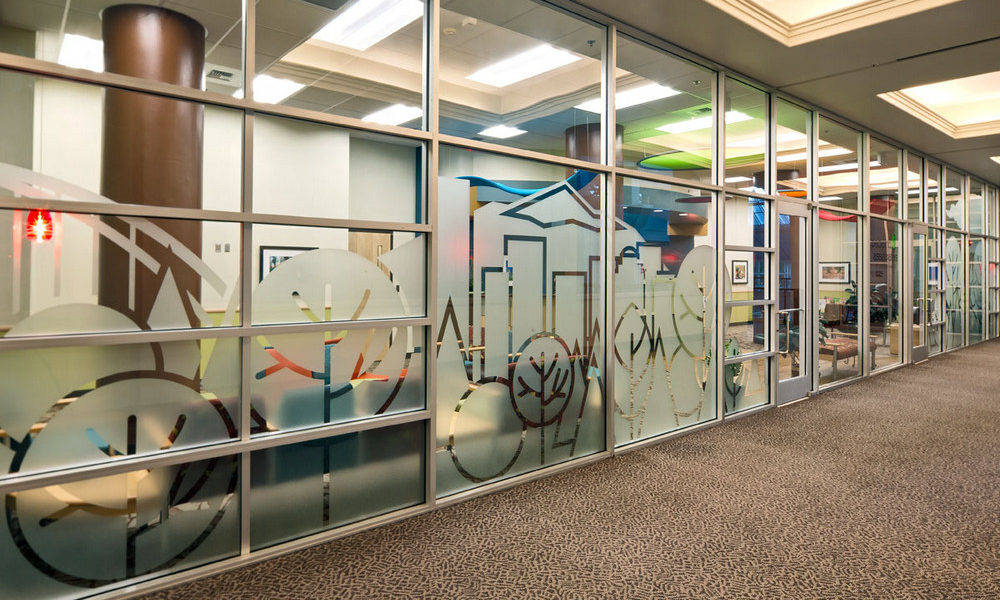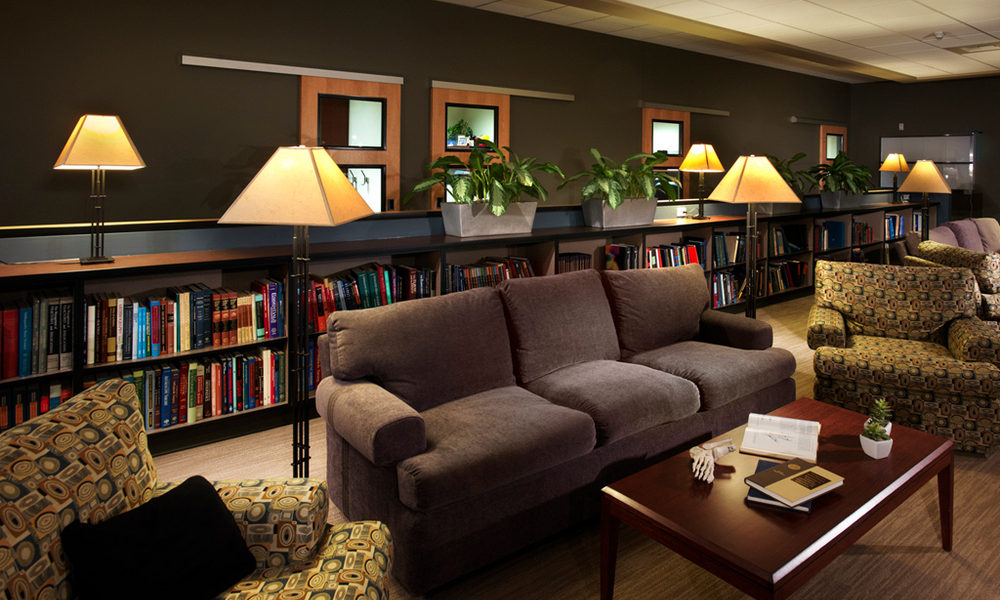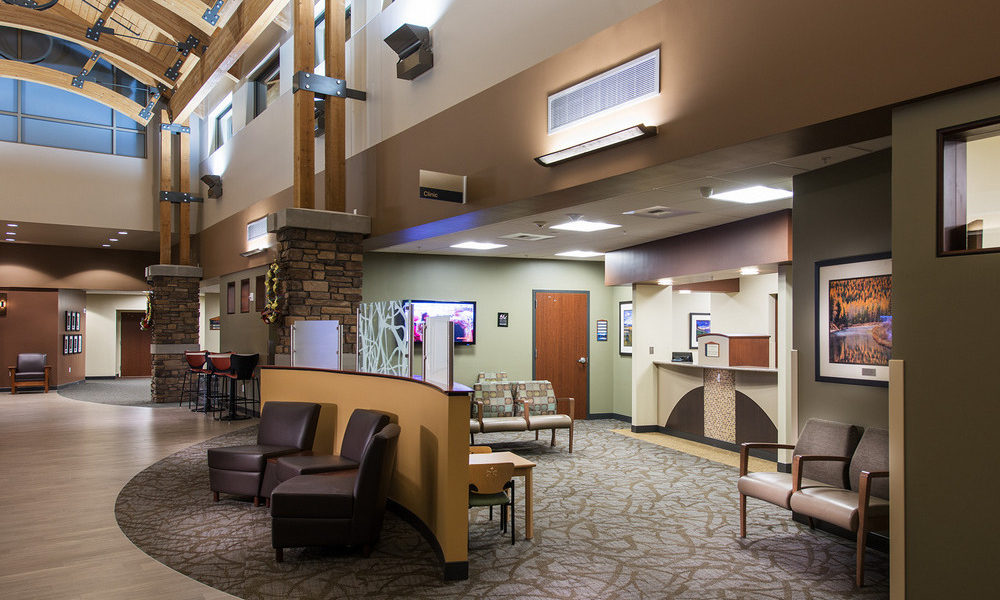 This custom-designed glass entry added playful privacy to the waiting of Pediatric Associates of the Northwest in Portland, Oregon. The design integrates the local community vibe into the pediatric facility with thoughtfulness and sensitivity to all ages of patients. Photo credit: David Kingham Photography.
This custom-designed glass entry added playful privacy to the waiting of Pediatric Associates of the Northwest in Portland, Oregon. The design integrates the local community vibe into the pediatric facility with thoughtfulness and sensitivity to all ages of patients. Photo credit: David Kingham Photography.  This project at the Slocum Center for Orthopedics & Sports Medicine, in Eugene, Oregon, included a focused physician library, designed for use as a decompression space. Photo credit: Ed Lacasse Photography.
This project at the Slocum Center for Orthopedics & Sports Medicine, in Eugene, Oregon, included a focused physician library, designed for use as a decompression space. Photo credit: Ed Lacasse Photography.  This open-concept waiting area in the DeerLodge Community Access Hospital, in DeerLodge, Montana, demonstrates how focused separations with partitions can break up waiting chairs without compromising the openness of the space. Photo credit: Ed Lacasse Photography.
This open-concept waiting area in the DeerLodge Community Access Hospital, in DeerLodge, Montana, demonstrates how focused separations with partitions can break up waiting chairs without compromising the openness of the space. Photo credit: Ed Lacasse Photography. Subscribe Now
Paradigm Shift of Pandemic Proportions Guides Next-Gen Facilities
By Sarah Jenk
A few short months ago, it would have been hard to imagine a single event with as much impact as the COVID-19 pandemic. Without notice, businesses across every industry and geography were forced to adapt to an entirely new reality, and to do so quickly.
Thankfully, the healthcare industry’s constant state of flux has prepared workers who support it, either directly or indirectly, to be adaptability experts. While architects, engineers and designers of healthcare facilities have the luxury of more lead time to respond to the impacts of COVID-19, we cannot wait to see how things play out. Now is the time to assess the ways this pandemic will change the healthcare experience, and to imagine the new world in which facilities will need to operate.
Those of us creating next-generation healthcare facilities should evaluate the new and challenging work conditions that care providers in both acute and non-acute facilities face. We should consider the stress level of patients, which is at an all-time high. In this new world, we need to provide solutions to create safer, more calming, healing and inclusive environments for all building occupants.
The new patient experience
In a post-pandemic world, established traditions and standards to guide the patient experience are changing. The welcome experience has been turned upside down in an effort to triage patients more quickly, curb the spread of germs and accommodate safe distancing guidelines.
Designers need to rethink building flow, planning for dramatically different traffic patterns. Instead of large, open-concept waiting rooms, we will see more emphasis on spaces that create separation between patients with a focus on the facilities’ processes to guide the design. Designers can utilize half-height divider walls and products, such as resin panels, to add division without sacrificing the feeling of openness.
Exam rooms will start to carry more weight as multipurpose spaces, where patients check in and out in the same place they are treated. To prepare for this expanded use of space, designers should think about ways to add patient-focused technology (e.g., touchscreens for automatic checkout and billing) for these new engagements inside the exam room.
The reprioritization of safety will also force designers to account for new types of interactions. For example, the rising popularity of telemedicine as a measure to prevent exposure to diseases will challenge designers to create seamless integrations between the virtual and in-person care experiences. As we see healthcare go digital, providers are integrating technology to manage the patient experience. Patients can now set up and manage their profile with clinics. They can control their preferences, request treatment by the same staff for each visit and communicate details so staff can review their case file prior to an in-person exam. Some facilities are going so far as to implement tracking systems so clinical staff are notified when patients enter the clinic, which eliminates the need to check-in. Designers can help clients think through these innovations. Discussion and collaboration around patient flow in the design process helps build a plan for the ideal patient experience, and identifies ways the facility can support varied experiences for different types of patients.
Successful designs in this new environment will also go beyond the patient experience, considering impacts on all building occupants – including visitors, care providers, staff and operational teams. The challenge is to create intuitive design for all ages, backgrounds, regions and functions. Stress and anxiety are universal emotions that drive almost every interaction that takes place in healthcare facilities — either in being a patient or providing care. Designers can make a dramatic impact in creating all-inclusive spaces by focusing on elements that minimize stress and give precedence to safety. This might include efforts to reflect nature and offer a biophilic experience, or solutions to support a multi-dimensional welcome experience as people have differing views of what feels “welcoming.” For example, a building might include wayfinding signage for people who prefer to see themselves around, coupled with strategically positioned stations for staff members to direct people who prefer interacting with a person.
Mobility is another key variable to consider in successfully implementing universal designs. Designers who thoughtfully connect services patients use most often and locate services with attention to accessibility (e.g., physical therapy space needs close proximity to the front entrance, nursing stations are centrally located between exam rooms, etc.) can help their clients elevate the healthcare experience.
Don’t overlook healthcare facilities as places of work
Healthcare facilities are stressful places to work: The stakes are high and the margin of error is razor thin. Since the COVID-19 pandemic, stressors have only risen as caregivers take on a burden of risk in contracting this deadly disease.
Designers can help minimize stress by focusing on safety elements of design — namely cleanliness and infection control — and by implementing stress-reducing design elements to all areas of the facility, not just those that serve patients. Tranquil artwork, healing gardens and natural design elements (e.g., wood-look materials, encapsulated water features) provide visual and auditory cues to help patients relax and recover. Clinical staff also play a critical role in alleviating patient stress. If we have spaces that help take care of the staff, they in turn will take better care of the patients. Providing doctors, nurses and other caregivers with respite areas and thoughtful workflows to help improve their efficiency can translate to better patient care, and ultimately, less stress for all building occupants.
Following the rise in popularity for respite spaces, there’s also been a shift away from designing dedicated, personal spaces (i.e., office space) for nurses and physicians to conduct their work outside of treating patients. Individual offices can run the risk of being under-utilized by occupants constantly in motion to meet the demands of their jobs. Instead, clients are moving to create more spaces where members of a care team can interact and share information, which supports accessibility and communication goals, but now requires even more evaluation of the materials used, and rethinking to adapt high-touch items to touchless operation, along with vigilance to ensure staff members are safe in these shared spaces.
With an emphasis on telemedicine, designers also need to consider new demands on caregivers’ time. In addition to providing tradition, in-person care, physicians and nurses will now also need to stay connected to patients virtually. This means more time spent in front of screens, which designers will need to accommodate with spaces that are flexible for telemedicine services, with video and telephone conferencing. This new work environment will also heighten the need for caregivers to have space to recharge and disconnect to minimize the stress of managing both in-patient care and telemedicine.
The requirements for flexibility are changing
Another paradigm shift the design community can anticipate in the wake of COVID-19 is an overall reduction in building size. Buildings in general will be smaller, but required to do more. For example, the same space might be set up to accommodate in-person exams, as well as be equipped with all of the technology solutions needed to practice telemedicine. This reality only elevates the importance of multifunctional spaces. As a result, designers will face steeper requirements to minimize spaces that could potentially sit unused (e.g., dedicated space for single-person use for caregivers who spend most of the day moving about a building).
As a result, designers will be challenged to mitigate the risks that come with multipurpose spaces, including attention to acoustics, privacy and most important, infection control.
Maintenance and cleaning practices will be the subject of specific attention as space within healthcare facilities moves to serve more functions with higher standards for cleanliness in the midst of a global pandemic. With more people utilizing less space, cleaning between the varying uses of a space will be more important than ever to keep people safe and prevent the spread of deadly diseases. Our materials will be challenged to keep up with cleaning demand, and aspects will have to be carefully evaluated through a multilayered lens to consider all of the impacts of the lifecycle of the materials.
This evaluation would include research into where materials are manufactured, where raw materials are procured from and durability testing to see how materials hold up to specific cleaning practices. Evaluation also helps designers build a better understanding of sustainability practices and ways to repurpose materials and/or set minimum standards for new materials to hold up in the harsh healthcare environment. Designers in 2020 must have a sense of how we are contributing to the social and economic impacts of society. If we select materials that add longevity to a facility life and re-use materials wherever possible, we’re adding that much more value for our clients and their communities.
Additionally, interiors will play a larger role in preventing the spread of contagion with renewed focus on maximum cleanability. We’ll see a move away from soft surfaces in place of those that are disinfectant-friendly. Designers will need to be mindful not to make overcorrections however; moving to all hard surfaces is not necessarily the answer to increase cleanability and safety as surfaces quickly repopulate and there is still a need for facilities to host good bacteria. We should also see the demand for antimicrobial coatings increase, with new technology and innovations in product design leading the way as coatings provide another solution for surface cleanability. With that coatings, there are a host of social and economic equalities and sustainability aspects to products, which require careful consideration. For designers, it’s critical to invest heavily in research into cleaning practices to educate clients on these new technologies, best practices and the products being developed, which will most certainly require interiors to follow suit.
Outside of cleaning practices, architects and designers can support facilities’ staff in combating the spread of infection by amping up ventilation systems and adding UV lights to support disinfecting process. Consideration for increased air exchanges with HEPA filters or increased MERV-rated filters, particularly in gathering spaces, will also aid in the fight to control viruses and add additional layers of protection to support infection control. It can also be beneficial to have dedicated space to convert into negative pressure exam rooms if needed. Planning is critical to ensure clients are well-versed in where to locate isolation spaces and how to make the best use of that space. Particularly for non-acute facilities, it may be unrealistic to maintain negative pressure rooms all the time, so it’s important to ensure clients are educated on the process, or have resources to rebalance pressure and maximize isolation spaces if and when needed to control infection.
We are in this together
One thought should ease anxieties about the uncertainty we face in a post-COVID-19 world: We are all in this together.
To that end, it’s important for designers to focus on building trust and partnership with clients now while we navigate substantial change. Create a united effort to identify design solutions with clients, not just for them. Work closely with clients to understand all of their needs. Speak to a wide variety of representatives and users of existing facilities and ground yourself in what they need to be successful. Engage with all different users of the space and consider each unique perspective about how a building can support the many layers of the healthcare experience. In doing so, we’ll see the next generation of healthcare facilities provide more utility and service to their communities than ever before.
Author: Sarah Jenk
Sarah Jenk is a senior interior designer for The Neenan Company. She can be reached at sarah.jenk@neenan.com.
Tags: Architecture, biophilia, COVID-19, healthcare interiors, next-generation facilities, telemedicine
Posted August 18, 2020
More Articles:
- Rethinking Healthcare Design to Address Post-Pandemic Workforce Shortage
- Telemedicine and Future of Health Facilities Design Explored in New Research Report
- State of Industry Examined in ‘Healthcare Reset’ Report
- Cam Twohey Joins Kahler Slater as Associate Principal, Senior Project Architect in Healthcare Market
- CxA Workshop & Exam
Apr 29, 2024 – Apr 30, 2024 - EMP Seminar & Exam at CxEnergy 2024
Apr 29, 2024 – Apr 30, 2024 - CxEnergy
Apr 29, 2024 – May 2, 2024 - PHCC West 2024
Apr 29, 2024 – May 2, 2024 - Lean in Design Forum 2024
May 1, 2024 – May 2, 2024 - IFMA’s Facility Fusion Conference & Expo
May 5, 2024 – May 7, 2024 - ASHE Academy 2024
May 6, 2024 – May 10, 2024










